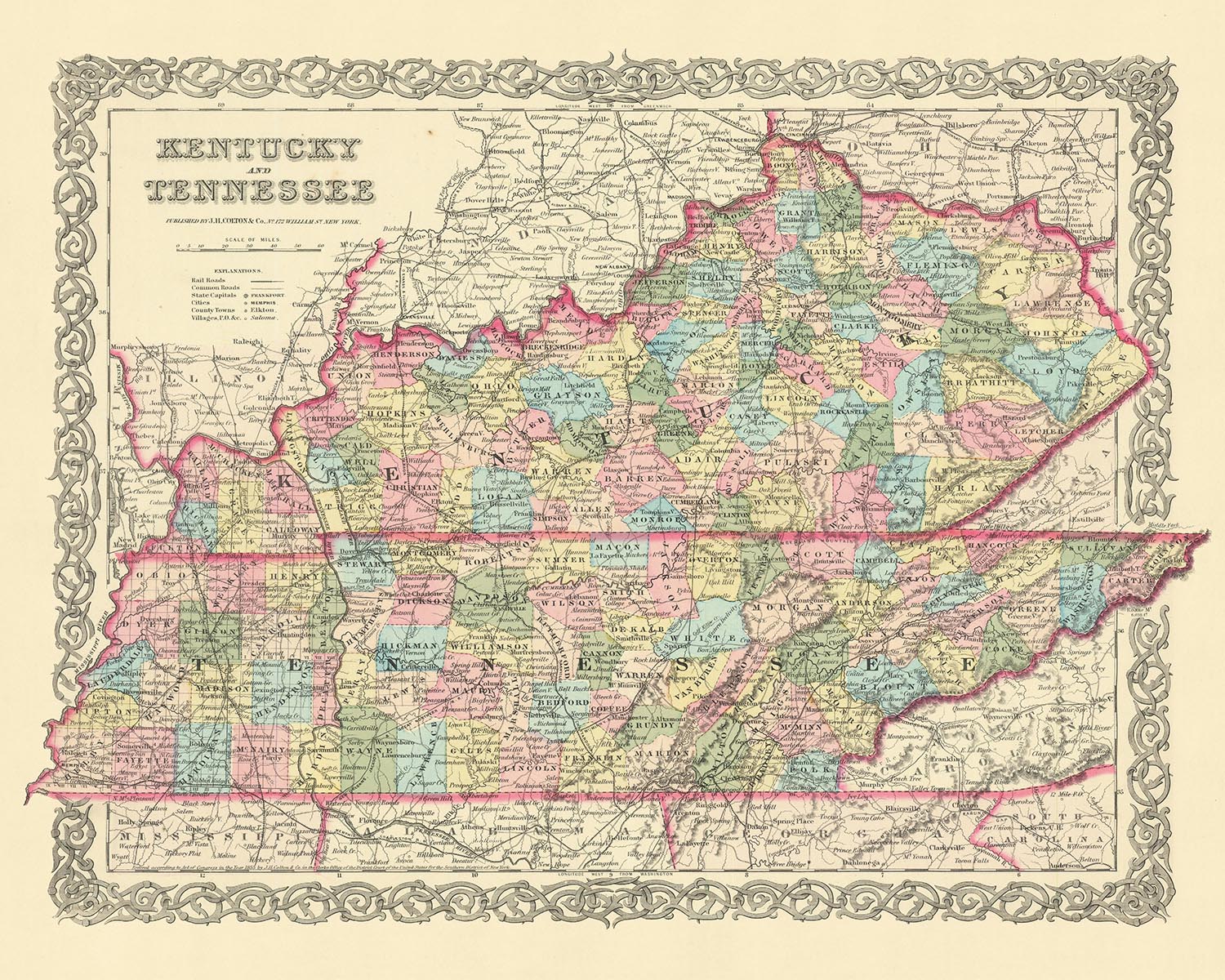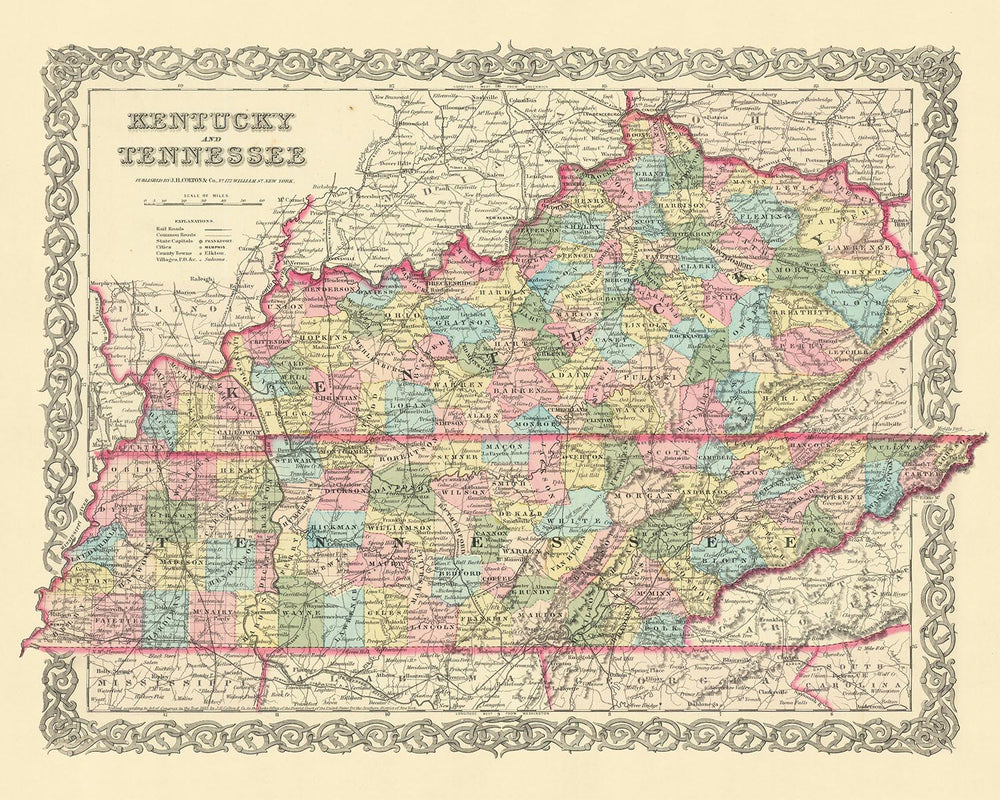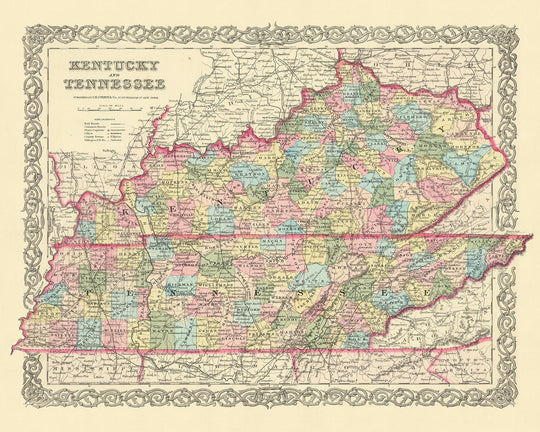- Handmade locally. No import duty or tax
- FREE Delivery by Christmas
- Love it or your money back (90 days)
- Questions? WhatsApp me any time
Own a piece of history
5,000+ 5 star reviews


Immerse yourself in the rich tapestry of American history with this exquisite old map of Kentucky and Tennessee, meticulously crafted by the renowned mapmaker, J. H. Colton, in 1855. A testament to Colton's reputation as one of the finest American mapmakers of his era, this map offers a rare glimpse into the early days of the United States, a time when many settlements were yet to be established and the nation was in the throes of defining its identity.
The map, a masterwork of 19th-century cartography, vividly captures the landscape of Kentucky as it was in 1855. It reveals a world where many modern-day cities and towns were yet to be founded, and the names and borders of existing settlements were still fluid and evolving. The map offers an invaluable insight into the growth and development of the region, showcasing the early stages of what would eventually become the modern state of Kentucky.
This map is a fascinating snapshot of Kentucky at a pivotal moment in its history. It highlights five of the most notable settlements of the time: Louisville, Lexington, Frankfort, Covington, and Bowling Green. Each of these settlements played a significant role in the shaping of Kentucky, and their depiction in this map serves as a reminder of their historical significance.
In this era, Kentucky was a land of promise and potential, a frontier on the cusp of change. This map encapsulates that sense of possibility, providing a unique perspective on a critical period in American history. It is more than just a map; it is a piece of history, a testament to the enduring spirit of exploration and discovery that has shaped the United States.
Whether you're a history enthusiast, a cartography lover, or simply someone who appreciates the beauty and craftsmanship of old maps, this piece is sure to captivate and inspire. It's not just a map—it's a journey back in time, a chance to explore the roots of Kentucky and the early days of the United States. With this map, you're not just observing history—you're experiencing it.
Kentucky Settlements Pre-1855
- Louisville (1778): Known as the largest city in Kentucky, it was an important shipping port in the 19th century.
- Lexington (1775): Known as the "Horse Capital of the World," it was a hub for thoroughbred horse racing and breeding.
- Frankfort (1786): The capital city of Kentucky, it was chosen for its central location.
- Covington (1815): Known for its historic architecture and vibrant arts scene.
- Bowling Green (1798): A key location during the Civil War, it was the Confederate capital of Kentucky.
- Paducah (1827): A strategic location during the Civil War, it was occupied by Union forces in 1861.
- Danville (1784): Known as the "City of Firsts," it was the site of the first post office west of the Alleghenies.
- Bardstown (1780): Known as the "Bourbon Capital of the World," it is home to the Kentucky Bourbon Festival.
- Maysville (1787): A significant port on the Ohio River for the tobacco trade.
- Pikeville (1822): Known for the Hatfield-McCoy feud, a notorious family feud in American history.
- Henderson (1797): John James Audubon, the famous naturalist, lived here and it's now home to the John James Audubon State Park.
- Harrodsburg (1774): The oldest city in Kentucky, it was the first permanent English settlement west of the Allegheny Mountains.
- Owensboro (1817): Known for its significant contributions to American music, including bluegrass and folk.
- Georgetown (1784): Home to Georgetown College, one of the oldest colleges in Kentucky.
- Richmond (1798): Site of the Battle of Richmond during the Civil War, one of the most decisive Confederate victories.
- Hopkinsville (1804): Known for the annual "Little Green Men" festival, commemorating a famous local UFO sighting.
- Elizabethtown (1797): Named after the wife of Colonel Andrew Hynes, it was a major stagecoach stop between Louisville and Nashville.
- Nicholasville (1798): Known for its historic downtown and as the home of Chrisman Mill Vineyards, Kentucky's oldest vineyard.
- Ashland (1854): Home to the Paramount Arts Center, an important regional hub for the performing arts.
- Winchester (1793): Known for its annual Beer Cheese Festival, celebrating a local culinary specialty.
Indian Tribes/Territories
- Cherokee: The Cherokee inhabited parts of southeastern Kentucky.
- Shawnee: The Shawnee had hunting grounds in central Kentucky.
- Chickasaw: The Chickasaw claimed parts of western Kentucky.
Notable Natural Phenomena
- Cumberland Gap: A key passageway through the Appalachian Mountains.
- Mammoth Cave: The world's longest cave system.
- Red River Gorge: Known for its unique sandstone arches and cliffs.
- Cumberland Falls: Sometimes called the "Niagara of the South."
Historical Events (1810-1855)
- War of 1812 (1812-1815): Kentucky supplied numerous troops and resources for the war effort.
- Mexican-American War (1846-1848): Many Kentuckians volunteered to fight in this war.
- The Compromise of 1850: This political agreement had significant impacts on the issue of slavery in Kentucky.
Please double check the images to make sure that a specific town or place is shown on this map. You can also get in touch and ask us to check the map for you.
This map looks great at all sizes: 12x16in (30.5x41cm), 16x20in (40.5x51cm), 18x24in (45.5x61cm), 24x30in (61x76cm), 32x40in (81.5x102cm), 40x50in (102x127cm), 48x60in (122x153cm) and 56x70in (142x178cm), but it looks even better when printed large.
I can create beautiful, large prints of this map up to 70in (178cm). Please get in touch if you're looking for larger, customised or different framing options.
The model in the listing images is holding the 16x20in (40.5x51cm) version of this map.
The fifth listing image shows an example of my map personalisation service.
If you’re looking for something slightly different, check out my main collection of USA and North America maps.
Please contact me to check if a certain location, landmark or feature is shown on this map.
This would make a wonderful birthday, Christmas, Father's Day, work leaving, anniversary or housewarming gift for someone from the areas covered by this map.
This map is available as a giclée print on acid free archival matte paper, or you can buy it framed. The frame is a nice, simple black frame that suits most aesthetics. Please get in touch if you'd like a different frame colour or material. My frames are glazed with super-clear museum-grade acrylic (perspex/acrylite), which is significantly less reflective than glass, safer, and will always arrive in perfect condition.
This map is also available as a float framed canvas, sometimes known as a shadow gap framed canvas or canvas floater. The map is printed on artist's cotton canvas and then stretched over a handmade box frame. We then "float" the canvas inside a wooden frame, which is available in a range of colours (black, dark brown, oak, antique gold and white). This is a wonderful way to present a map without glazing in front. See some examples of float framed canvas maps and explore the differences between my different finishes.
For something truly unique, this map is also available in "Unique 3D", our trademarked process that dramatically transforms the map so that it has a wonderful sense of depth. We combine the original map with detailed topography and elevation data, so that mountains and the terrain really "pop". For more info and examples of 3D maps, check my Unique 3D page.
For most orders, delivery time is about 3 working days. Personalised and customised products take longer, as I have to do the personalisation and send it to you for approval, which usually takes 1 or 2 days.
Please note that very large framed orders usually take longer to make and deliver.
If you need your order to arrive by a certain date, please contact me before you order so that we can find the best way of making sure you get your order in time.
I print and frame maps and artwork in 23 countries around the world. This means your order will be made locally, which cuts down on delivery time and ensures that it won't be damaged during delivery. You'll never pay customs or import duty, and we'll put less CO2 into the air.
All of my maps and art prints are well packaged and sent in a rugged tube if unframed, or surrounded by foam if framed.
I try to send out all orders within 1 or 2 days of receiving your order, though some products (like face masks, mugs and tote bags) can take longer to make.
If you select Express Delivery at checkout your order we will prioritise your order and send it out by 1-day courier (Fedex, DHL, UPS, Parcelforce).
Next Day delivery is also available in some countries (US, UK, Singapore, UAE) but please try to order early in the day so that we can get it sent out on time.
My standard frame is a gallery style black ash hardwood frame. It is simple and quite modern looking. My standard frame is around 20mm (0.8in) wide.
I use super-clear acrylic (perspex/acrylite) for the frame glass. It's lighter and safer than glass - and it looks better, as the reflectivity is lower.
Six standard frame colours are available for free (black, dark brown, dark grey, oak, white and antique gold). Custom framing and mounting/matting is available if you're looking for something else.
Most maps, art and illustrations are also available as a framed canvas. We use matte (not shiny) cotton canvas, stretch it over a sustainably sourced box wood frame, and then 'float' the piece within a wood frame. The end result is quite beautiful, and there's no glazing to get in the way.
All frames are provided "ready to hang", with either a string or brackets on the back. Very large frames will have heavy duty hanging plates and/or a mounting baton. If you have any questions, please get in touch.
See some examples of my framed maps and framed canvas maps.
Alternatively, I can also supply old maps and artwork on canvas, foam board, cotton rag and other materials.
If you want to frame your map or artwork yourself, please read my size guide first.
My maps are extremely high quality reproductions of original maps.
I source original, rare maps from libraries, auction houses and private collections around the world, restore them at my London workshop, and then use specialist giclée inks and printers to create beautiful maps that look even better than the original.
My maps are printed on acid-free archival matte (not glossy) paper that feels very high quality and almost like card. In technical terms the paper weight/thickness is 10mil/200gsm. It's perfect for framing.
I print with Epson ultrachrome giclée UV fade resistant pigment inks - some of the best inks you can find.
I can also make maps on canvas, cotton rag and other exotic materials.
Learn more about The Unique Maps Co.
Map personalisation
If you're looking for the perfect anniversary or housewarming gift, I can personalise your map to make it truly unique. For example, I can add a short message, or highlight an important location, or add your family's coat of arms.
The options are almost infinite. Please see my map personalisation page for some wonderful examples of what's possible.
To order a personalised map, select "personalise your map" before adding it to your basket.
Get in touch if you're looking for more complex customisations and personalisations.
Map ageing
I have been asked hundreds of times over the years by customers if they could buy a map that looks even older.
Well, now you can, by selecting Aged before you add a map to your basket.
All the product photos you see on this page show the map in its Original form. This is what the map looks like today.
If you select Aged, I will age your map by hand, using a special and unique process developed through years of studying old maps, talking to researchers to understand the chemistry of aging paper, and of course... lots of practice!
If you're unsure, stick to the Original colour of the map. If you want something a bit darker and older looking, go for Aged.
If you are not happy with your order for any reason, contact me and I'll get it fixed ASAP, free of charge. Please see my returns and refund policy for more information.
I am very confident you will like your restored map or art print. I have been doing this since 1984. I'm a 5-star Etsy seller. I have sold tens of thousands of maps and art prints and have over 5,000 real 5-star reviews. My work has been featured in interior design magazines, on the BBC, and on the walls of dozens of 5-star hotels.
I use a unique process to restore maps and artwork that is massively time consuming and labour intensive. Hunting down the original maps and illustrations can take months. I use state of the art and eye-wateringly expensive technology to scan and restore them. As a result, I guarantee my maps and art prints are a cut above the rest. I stand by my products and will always make sure you're 100% happy with what you receive.
Almost all of my maps and art prints look amazing at large sizes (200cm, 6.5ft+) and I can frame and deliver them to you as well, via special oversized courier. Contact me to discuss your specific needs.
Or try searching for something!














































